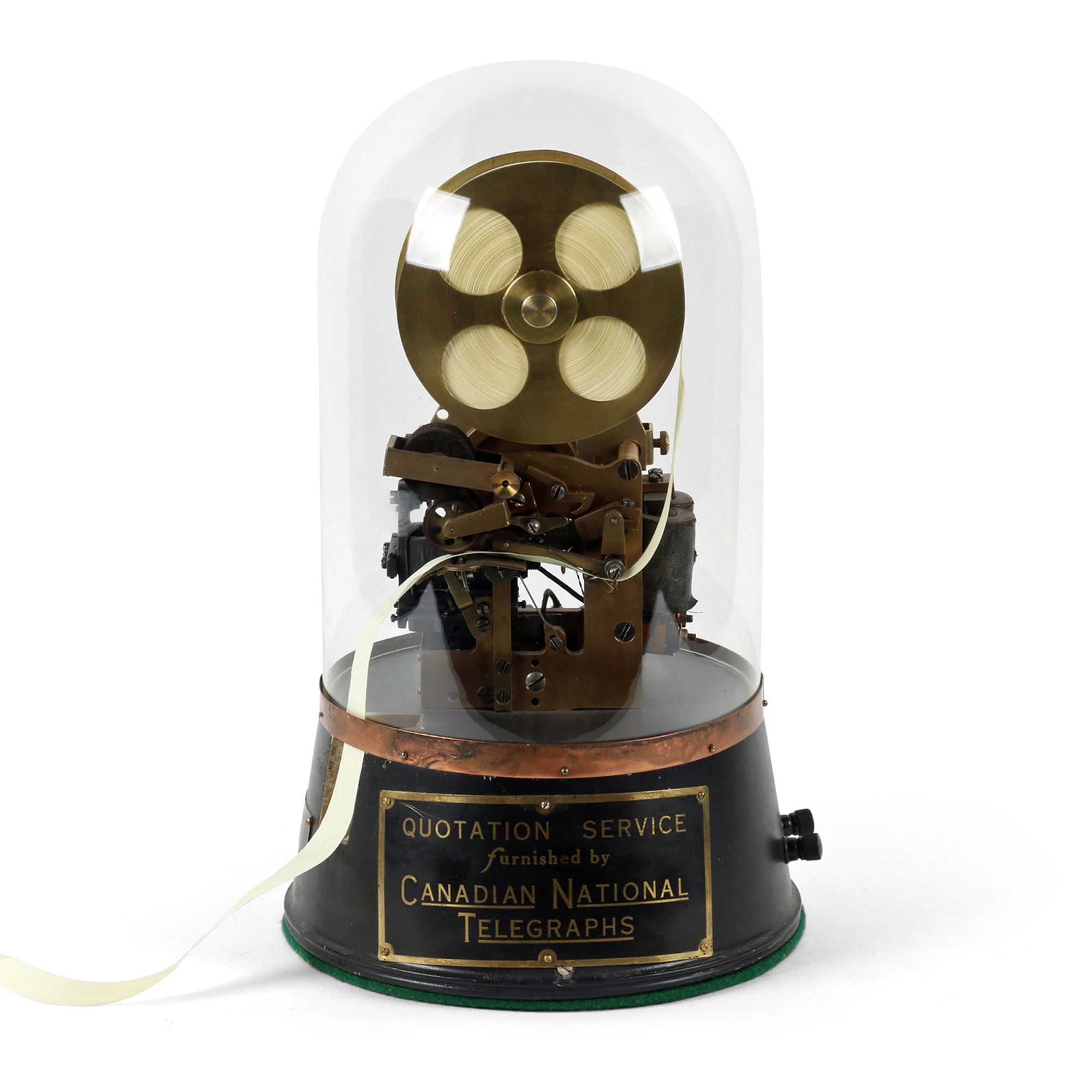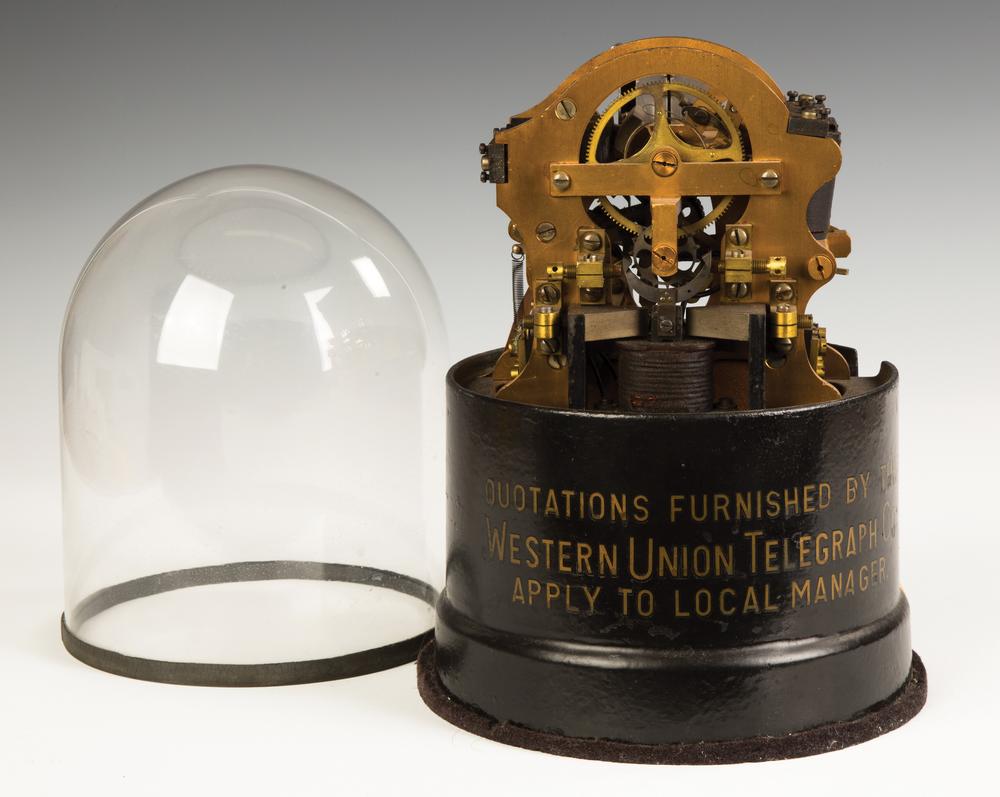This machine helped lay the foundation for the stock market as we know it.
This Burry model ticker will be featured in Miller & Miller’s ‘Mantiques’ auction on September 14, 2019. It was discovered in the 1980s sitting in an old radio repair shop in Toronto.
‘Oh, the ticker, oh the ticker. How I yearn to get rich quicker.’
These were the opening lines of a 1910 song published in The Ticker, an American magazine geared to investors.
The world of buying and selling stocks and bonds was revolutionized by stock tickers. Instead of relying on the mail or messengers, who would run back and forth between brokers’ offices and the trading floors, these machines used telegraph lines to transmit up-to-the-minute information vital to financial markets.
This Burry model, used by the Canadian National Telegraph service, will be featured in Miller & Miller’s ‘Mantiques’ auction on September 14, 2019. It was discovered in the 1980s sitting in an old radio repair shop in Toronto.
The first stock ticker, invented by Edward Calahan, debuted in 1867 in New York City. Seventy-five years earlier, the first seeds of the New York Stock Exchange were planted when 24 stockbrokers met beneath a Buttonwood tree in New York to sign the Buttonwood Agreement – the groundwork which led to the creation in 1817 of the New York Stock and Exchange Board, later renamed simply the New York Stock Exchange. Today, it’s the world’s largest stock exchange with more than $165 billion worth of daily trading.
The old stock tickers printed abbreviations of company names, stock prices and trade volumes, which came out on long streams of narrow paper (the same streams later used in ticker tape parades). They were called stock ‘tickers’ because of the sound the machines made as they printed off this vital information.
The old stock tickers printed abbreviations of company names, stock prices and trade volumes on long streams of narrow paper like ones these women are holding in 1918.
“Before the ticker’s invention, getting the best price on the commodity market meant getting the fastest runner you could,” according to smithsonianmag.com. “At the time, the flood of runners sprinting back and forth between the brokerages and stock exchange was so thick that passersby could easily be swept up in the flow.”
There were a number of variations of stock tickers introduced over the years. This particular model was invented by John Burry in 1914, hence its name the Burry Ticker. According to edisonticker.com, John Burry is credited with making his mechanism lighter and adding a self-winding feature. They were manufactured for $32 each by O.F. Ehrle, of New York, for the Gold and Stock Telegraph Company, which leased them to Western Union for $3 each. Western Union, which for years dominated the American telegraph industry, used them from 1914 to 1922 in a number of cities.
It’s estimated there were fewer than 1,000 of the Burry Tickers made. So not only are they historically significant, they’re rare.
Inventor Thomas Edison, a name familiar to most people, came up with his own version of the stock ticker in 1871, also for the Gold and Stock Telegraph Company. Edison added a mechanism which would synchronize multiple tickers so they reliably printed the same information at the same time, something that had become a problem since printers frequently fell out of unison and had to be reset. He also added a transmitter to his stock tickers, much like the keyboard of a typewriter.
Inventor Thomas Edison, a name familiar to most people, came up with his own version of the stock ticker in 1871.
It’s been suggested that Edison’s stock ticker is what made him wealthy enough to build his famous Menlo Park lab in New Jersey, paving the way for his future contributions to science and technology and the fame that came with them. Included in those accomplishments was his perfection of the electric lightbulb, something he did not invent, but dramatically improved upon. (Interestingly, when Edison was just 16 he worked briefly as a night telegraph operator at the Stratford, Ontario train station, just 23 kilometers west of Miller & Miller Auctions in New Hamburg. When he fell asleep on the job and two trains nearly collided because of it, he fled Canada and returned to his home in Michigan. Learn More)
Stock tickers were used for close to a century until more modern technology made them obsolete in the 1960s. Today, there are few surviving examples and they rarely come onto the open market. Miller & Miller estimates its featured Burry Model to sell between $3,500 and $5,000.
“Stock tickers may be long gone from exchange floors,” notes smithsonianmag.com, “but they laid the foundations for the lightning-quick connected world of the modern financial system.”
In 1908, The Ticker magazine also wrote of a mental disorder caused by the machine: speculitis.
Story By Diane Sewell
Item Estimate: $3500 - 5000
Lot Number: 227
Auction Details: Mantiques! - September 14th, 2019. 9 am.
Live Auction Location: 59 Webster St. New Hamburg, Ontario. N3A 1W8
Did you enjoy this article? Feel free to share it using the buttons below:



